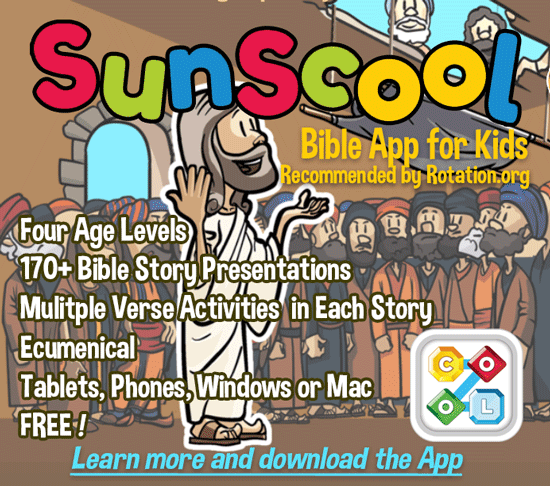The Ten Lepers
Computer Workshop
Summary of Lesson Activities:
Uses the software program "Let's Talk" (Sunday Software).
 Note: This software is FREE to supporting members, Learn more here!
Note: This software is FREE to supporting members, Learn more here!
Scripture Reference:
Luke 17:11-19
Supplies List:
Leader Preparation:
- Gather the materials.
- Preview the software.
- Read the scripture ahead of time.
Presentation
Opening-Welcome and Lesson Introduction:
Greet the children and introduce yourself.
Open with a prayer.
Dig-Main Content and Reflection:
The healing of the ten lepers is another one of those great Jesus stories which has RICH DIALOG POSSIBILITIES to work with in software.
- What excuses might the 9 lepers have given for not going back to talk to Jesus?
- What might Jesus have said to each of those specific excuses?
- What did the 1 healed leper do AFTER he thanked Jesus? (Was 'thanking' enough?)
- Imagine what the 1 leper said to his parents, ...his friends.
- Imagine what that 1 leper told the religious authorities after thanking Jesus.
- Imagine what that 1 leper said to the OTHER 9 when he caught up to them!!
- Imagine YOU are the "leper" ...what is your problem... your dis-ease? How would a person ask Jesus for healing if they suffered from LONELINESS or SADNESS or BAD THOUGHTS in their head? This is a powerful question you can pose in several different ways. The kids will need help thinking through their options and wording.
- What might Jesus say to you about your specific problem? How does Jesus heal sadness? or loneliness? or someone who is dying? (insert a problem here)
Software Technique:
Whenever I encounter a story like this with rich dialog possibilities and questions that "could have been included" in the story, I tend to look at "Let's Talk" (Sunday Software). Let's Talk software allows your students to create an onscreen animated character who will speak aloud whatever the kids type.
So....After my Ten Lepers Bible study with the kids, I would have them go to Let's Talk screen, create their character, and then POSE QUESTIONS to them (such as those I've listed above), either one at a time, or a different question to a different computer group, then give them 3 minutes to answer the question. Then we go to each computer to hear each group's response. Then I'd pose another question...and so on.
For this story, I've use some of the questions found above. However, inevitably NEW questions come from the kids and I might use one of their raised questions or insights as my next question for their animated character to answer.
I might also simply have them RE-WRITE a new chapter to the story. For example: Imagine another leper decided to go look for Jesus after presenting himself to the priests. Where would he find Jesus? How do WE find Jesus? (This question is pretty deep. Remember the story of the Fourth Wiseman who went looking for Jesus and kept getting side-tracked by helping others?)
Closing:
End with a prayer.
NOTES:
Because Let's Talk software allows kids to have their onscreen persona answer FOR THEM, some will be more likely to open up, than if they had to say it themselves in front of the class.
For younger kids, you can collect IMAGES ahead of time of people who have a problem and imagine what that person could say to Jesus and what Jesus would say to those specific people and their problem. You can collect these images from the internet, and paste them into documents ...and either have the kids type "captions" with each photo, and print, or have them write captions on the printed photos.
The story of the ten lepers is NOT found in Life of Christ CD.
A lesson written by Neil MacQueen
A representative of Rotation.org reformatted this post to improve readability.
Disclaimer: I created the software in question. My interest in teaching with software and subsequent software work grew out of my work with the Rotation Model. I appreciate the Rotation.org Board encouraging me to post my lesson ideas here and encourage you to do the same.

 Note: This software is FREE to supporting members,
Note: This software is FREE to supporting members, 

